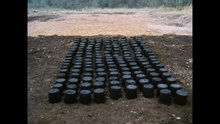Klütt


Simple, pre-industrial hand-made lignite compacts from the Rhenish mining area were referred to as Klütten ( zero plural ), Klütt or Klüt (derived from Low German “Kluit” = “(Erd-) Klumpen” , Rhenish klût ) . Later the name was generalized colloquially in the Rhenish and Cologne dialects and was also used for industrially pressed briquettes .
Traditional klütten production

Traditional Klütten were made by Klüttenbäckers in the early days of the Rhenish lignite mining in the 18th and 19th centuries . These were often farmers who, as a sideline, ran small lignite mines by hand on their fields. These so-called hollows were only a few meters deep, up to the groundwater level, not comparable to the large open-cast mines of later times.
For the production of the clumps, the extracted brown coal, then called turf , was mixed with water and other binders ( clay , cow dung , ...) and kneaded into a doughy mass by stepping on it . The mass was tamped with hands and feet into wooden, frustoconical buckets, so-called Klüttenbüttchen , and then thrown. The bodies formed in this way were dried by sitting in the air using the wind and sun. Since the fresh clogs easily disintegrated again in heavy rain, the clogs were mainly made in summer. If the blocks were sufficiently pre-dried, they were stacked on benches to form pyramids of up to 100,000 pieces, which were covered with straw mats to protect them from rain or placed under a low protective roof or in a shed.
A log weighed about 6 pounds when wet and about 4 pounds when dried. The Klüttenbäckerei place in hired house ( chord ); a comradeship of two workers could produce about 500 blocks a day.
As a result of the drying, the water content of the lignite decreased (from over 60% in favorable weather down to 35%). But even without reducing the water content, the processing of the coal into Klütten meant an appreciation, because in lump form the coal was easier to store, transport and trade.
The cliffs were primarily used by the poor rural population as house fire , i.e. as fuel for the stove, because lignite burns relatively poorly even in pre-dried form (high water and ash content → poor calorific value , a lot of smoke , strong smell, ...) and was therefore opposite expensive coal and inferior wood. Lignite was not usable for the heavy industry that was emerging at that time; Only a few local small businesses (breweries, brickworks, ...) were supplied.
At the end of the 19th century, the traditional blocks were more and more replaced by machine-made wet- pressed blocks , and later by the invention of the briquette press by Carl Exter, by dry-pressed briquettes from the briquette factories that were numerous at the time .
literature
- Friedhelm Ruf, Volker Schüler , Manfred Coenen: The Rheinische Braunkohlenrevier 1877 to 1957 , Sutton Verlag, 2004.
- Walter Buschmann , Norbert Gilson, Barbara Rinn: Brown coal mining in the Rhineland , ed. from LVR and MBV-NRW , 2008, ISBN 978-3-88462-269-8 .
- Fritz Wündisch : From Klütten and Briquettes, pictures from the history of the Rhenish lignite mining , Weiden, 1964.
Web links
Individual evidence
- ^ Fritz Wündisch: Memories of Donatus from the home calendar of the Euskirchen district , 1964, online at www.wisoveg.de (accessed November 30, 2009)
- ↑ a b Manfred Coenen, Volker HW Schüler : The industrial and traffic engineering development in lignite mining on the left bank of the Rhine 1877-1913, online at www.dbhverlag.de (accessed on November 30, 2009).
- ↑ a b Rhenish dictionary: Klut III. DFG Dictionary Network, Competence Center for Electronic Indexing and Publication Processes in the Humanities, University of Trier, accessed on March 19, 2012 .
- ↑ a b c d e The history of the lignite industry in our homeland on kerpen-brueggen.net ( Memento of the original from February 6, 2005 in the Internet Archive ) Info: The archive link was automatically inserted and not yet checked. Please check the original and archive link according to the instructions and then remove this notice. .
- ↑ From Klütten and Briquettes on rwe.com
- ↑ Quarks & Co., WDR television: How it all began. The history of lignite in the Rhineland on wdr.de (accessed November 30, 2009).
- ↑ Buschmann, p. 45.
- ↑ a b Ottmar Prothmann: Brown coal mining near Leimersdorf on www.kreis.aw-online.de (Ahrweiler district administration) ( Memento of the original from September 14, 2008 in the Internet Archive ) Info: The archive link was inserted automatically and has not yet been checked. Please check the original and archive link according to the instructions and then remove this notice. (accessed November 30, 2009).
- ↑ Our homeland's greatest wealth. The beginnings of lignite mining. In: Kölnische Rundschau of July 29, 1950, online at wisoveg.de (accessed November 30, 2009).


